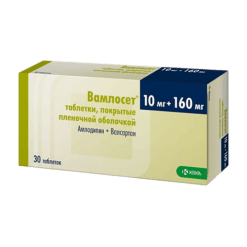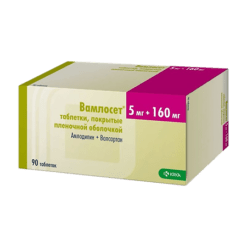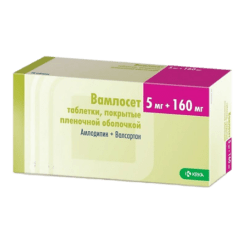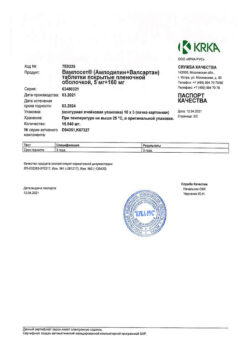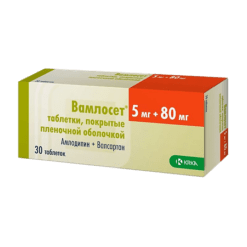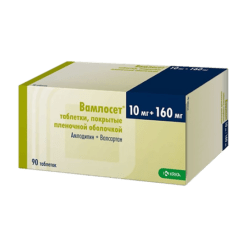No products in the cart.
Vamloset, 5 mg+80 mg 90 pcs
€25.75 €23.23
Description
Hypotensive combined agent (slow calcium channel blocker + angiotensin II receptor antagonist).
Indications
Indications
Arterial hypertension (patients for whom combination therapy is indicated).
Pharmacological effect
Pharmacological effect
antihypertensive combination drug (slow calcium channel blocker + angiotensin II receptor antagonist).
Special instructions
Special instructions
Impaired liver function of mild (5-6 points on the Child-Pugh scale) and moderate (7-9 points on the Child-Pugh scale) severity, as well as in obstructive diseases of the biliary tract, unilateral or bilateral stenosis of the renal arteries or stenosis of the artery of a single kidney, chronic heart failure (CHF) III-IV functional class according to the NYHA classification, acute coronary syndrome, after an acute infarction myocardium, hyperkalemia, hyponatremia, diet with limited salt intake, reduced circulating blood volume (CBV) (including diarrhea, vomiting).
As with other vasodilators, special caution should be exercised when used in patients with mild to moderate mitral or aortic stenosis and hypertrophic obstructive cardiomyopathy (HOCM).
Since there is insufficient data on the safety and effectiveness of Vamloset® in children and adolescents (under 18 years of age), the drug is not recommended for use in patients in this category.
Patients with impaired renal function
For patients with mild to moderate renal impairment (creatinine clearance ³ 30 ml/min), no adjustment of the initial dose is required.
Patients with liver dysfunction
Due to the presence of valsartan and amlodipine, Vamloset® should be used with caution in patients with impaired liver function and obstructive diseases of the biliary tract. In patients in this category, if necessary, it is possible to reduce the initial dose of Vamloset® to the one containing the smallest dose of amlodipine, i.e. 1 tablet containing amlodipine/valsartan at a dose of 5/80 mg or 5/160 mg.
Elderly patients (over 65 years old)
In patients over 65 years of age, no dose adjustment is required. In patients in this category, if necessary, it is possible to reduce the initial dose of Vamloset® to the one containing the smallest dose of amlodipine, i.e. 1 tablet containing amlodipine/valsartan at a dose of 5/80 mg or 5/160 mg.
Patients with hyponatremia and/or decreased blood volume
In patients with uncomplicated arterial hypertension receiving therapy with the amlodipine/valsartan combination, severe arterial hypotension was observed in 0.4% of cases.
In patients with an activated RAAS (for example, in patients with dehydration and/or hyponatremia taking diuretics in high doses), symptomatic arterial hypotension may develop when taking ARA II. Before starting treatment, it is recommended to restore sodium levels and/or replenish blood volume, in particular by reducing the doses of diuretics or starting therapy under close medical supervision.
If a pronounced decrease in blood pressure develops, the patient should be placed in a horizontal position with legs elevated and, if necessary, given an intravenous infusion of 0.9% sodium chloride solution. Therapy with Vamloset® can be continued after stabilization of hemodynamic parameters.
Hyperkalemia
Caution should be exercised when using potassium-sparing diuretics, potassium supplements, dietary supplements containing potassium, or other drugs that can increase plasma potassium levels (eg, heparin). It is necessary to regularly monitor the potassium content in the blood plasma.
Renal artery stenosis
The drug Vamloset® should be used with caution in patients with arterial hypertension against the background of unilateral or bilateral renal artery stenosis or stenosis of the artery of a single kidney, taking into account the possibility of increasing serum concentrations of urea and creatinine.
Condition after kidney transplantation
The safety of the amlodipine/valsartan combination in patients who have recently undergone kidney transplantation has not been established.
Liver dysfunction
Valsartan is predominantly excreted unchanged in bile. In patients, T1/2 is prolonged and AUC is increased. Caution should be exercised when using Vamloset® in patients with mild (5-6 points on the Child-Pugh scale) or moderate (7-9 points on the Child-Pugh scale) impaired liver function or obstructive diseases of the biliary tract.
Renal dysfunction
No dose adjustment of Vamloset® is required in patients with mild to moderate renal impairment. In patients with moderate renal impairment, monitoring of potassium levels and plasma creatinine concentrations is recommended. The simultaneous use of ARB II, including valsartan, or ACE inhibitors with aliskiren is contraindicated in patients with impaired renal function (creatinine clearance less than 60 ml/min).
Primary hyperaldosteronism
Considering the damage to the RAAS in primary hyperaldosteronism, these patients should not be prescribed ARA II, including valsartan.
Angioedema
Among patients with angioedema (including swelling of the larynx and vocal cords, causing airway obstruction and/or swelling of the face, lips, pharynx and/or tongue) during therapy with Vamloset®, cases of angioedema development in the anamnesis have been observed, including in response to ACE inhibitors. If angioedema develops, the drug should be discontinued immediately and the possibility of repeated use should be excluded.
Heart failure/myocardial infarction
In patients whose renal function may depend on the activity of the RAAS (for example, in severe CHF), therapy with ACE inhibitors and ARA II is accompanied by oliguria and/or an increase in azotemia, and in rare cases, acute renal failure and/or death. Similar outcomes have been described with valsartan. In patients with CHF or previous myocardial infarction, renal function should always be assessed.
In patients with CHF of non-ischemic etiology of functional class III-IV according to the NYHA classification, the use of amlodipine was accompanied by an increase in the incidence of pulmonary edema compared with placebo, with no significant difference in the incidence of worsening CHF between the two groups. Blockers of “slow” calcium channels, including amlodipine, should be used with caution in patients with CHF, as the risk of cardiovascular complications and death may increase.
Mild to moderate aortic valve and mitral valve stenosis, HOCM
As with any vasodilator, caution should be exercised in patients with mitral stenosis and mild to moderate aortic stenosis, HOCM. The amlodipine/valsartan combination has been studied only in patients with arterial hypertension.
When using the drug Vamloset®, you must be careful when driving vehicles and other technical devices that require increased concentration and speed of psychomotor reactions, as dizziness, fatigue and nausea may occur.
Active ingredient
Active ingredient
Amlodipine, Valsartan
Composition
Composition
for 1 tablet 5 mg + 80 mg
Core:
Active ingredients:
Amlodipine besylate (amlodipine besilate) 6.94 mg, equivalent to amlodipine 5.00 mg Valsartan A, granule substance 125.675 mg
[Active ingredient of granular substance: Valsartan 80.00 mgExcipients of the granule substance: microcrystalline cellulose, croscarmellose sodium, povidone K-25, sodium lauryl sulfate]
Excipients: mannitol, magnesium stearate, colloidal silicon dioxide
Film shell:
Opadry II white1, iron oxide yellow (E172)
for 1 tablet 5 mg + 160 mg
Core:
Active ingredients:
Amlodipine besylate (amlodipine besilate) 6.94 mg, equivalent to amlodipine 5.00 mg Valsartan A, granule substance 251.35 mg
[Active ingredient of granular substance: Valsartan 160.00 mgExcipients of the granule substance: microcrystalline cellulose, croscarmellose sodium, povidone K-25, sodium lauryl sulfate]
Excipients: mannitol, magnesium stearate, colloidal silicon dioxide
Film shell:
Opadry II white1, iron oxide yellow (E172)
for 1 tablet 5 mg + 320 mg
Core:
Active ingredients:
Amlodipine besilate (amlodipine besylate) 6.94 mg, equivalent to amlodipine 5.00 mg
Valsartan A, granule substance 502.70 mg
[Active ingredient of granular substance: Valsartan 320.00 mgExcipients of the granule substance: microcrystalline cellulose, croscarmellose sodium, povidone K-25, sodium lauryl sulfate]
Excipients: mannitol, magnesium stearate, colloidal silicon dioxide
Film shell:
Opadry II white1, iron oxide yellow (E172), iron oxide red (E172)
for 1 tablet 10 mg + 160 mg
Core:
Active ingredients:
Amlodipine besilate (amlodipine besilate) 13.88 mg, equivalent to amlodipine 10.00 mg
Valsartan A, granule substance 251.35 mg
[Active ingredient of granular substance: Valsartan 160.00 mgExcipients of the granule substance: microcrystalline cellulose, croscarmellose sodium, povidone K-25, sodium lauryl sulfate]
Excipients: mannitol, magnesium stearate, colloidal silicon dioxide
Film shell:
Opadry II white1, iron oxide yellow (E172)
for 1 tablet 10 mg + 320 mg
Core:
Active ingredients:
Amlodipine besilate (amlodipine besilate) 13.88 mg, equivalent to amlodipine 10.00 mg
Valsartan A, granule substance 502.70 mg
[Active ingredient of granular substance: Valsartan 320.00 mgExcipients of the granule substance: microcrystalline cellulose, croscarmellose sodium, povidone K-25, sodium lauryl sulfate]
Excipients: mannitol, magnesium stearate, colloidal silicon dioxide
Film shell:
Opadry II white1, iron oxide yellow (E172)
1 Opadry II white: polyvinyl alcohol, titanium dioxide (E171), macrogol, talc.
Pregnancy
Pregnancy
Pregnancy
The use of Vamloset® is contraindicated during pregnancy.
Considering the mechanism of action of ARA II, a risk to the fetus cannot be excluded when using the drug in the first trimester of pregnancy.
Like any other drug that directly affects the renin-angiotensin-aldosterone system (RAAS), Vamloset® should not be used during pregnancy or in women planning pregnancy. When using drugs that affect the RAAS, it is necessary to inform women of childbearing age about the potential risk of negative effects of these drugs on the fetus during pregnancy. When planning pregnancy, it is recommended that the patient be transferred to alternative antihypertensive therapy, taking into account the safety profile. If pregnancy is diagnosed, you should stop taking Vamloset® and, if necessary, switch to alternative antihypertensive therapy.
The drug Vamloset®, like other drugs that have a direct effect on the RAAS, is contraindicated in the II-III trimesters of pregnancy, since it can cause fetotoxic effects (impaired renal function, delayed ossification of fetal skull bones, oligohydramnios) and neonatal toxic effects (renal failure, arterial hypotension, hyperkalemia) and fetal death. If, nevertheless, the drug was used in the II-III trimesters of pregnancy, then it is necessary to conduct an ultrasound examination of the kidneys and bones of the fetal skull. Newborns whose mothers took Vamloset® during pregnancy should be monitored, as arterial hypotension may develop in the newborn.
Breastfeeding period
It is not recommended to use Vamloset® during breastfeeding. If it is necessary to use the drug Vamloset® during lactation, breastfeeding should be discontinued.
Experience with amlodipine shows that amlodipine is excreted into human breast milk. The mean milk/plasma ratio for amlodipine concentration was 0.85 among 31 lactating women who had pregnancy-related hypertension and received amlodipine at an initial dosage of 5 mg per day. The dosage of the drug was adjusted if necessary (depending on the average daily dose and weight: 6 mg and 98.7 mcg/kg, respectively). The estimated daily dose of amlodipine received by an infant through breast milk is 4.17 mcg/kg.
Contraindications
Contraindications
Hypersensitivity to amlodipine, other dihydropyridine derivatives, valsartan, as well as to other auxiliary components of the drug.
Hereditary angioedema, or edema in patients during previous therapy with ARA II.
· Severe liver failure (more than 9 points on the Child-Pugh scale), biliary cirrhosis and cholestasis.
· Severe renal failure (creatinine clearance less than 30 ml/min), use in patients on hemodialysis.
Pregnancy planning, pregnancy and breastfeeding.
· Severe arterial hypotension (systolic blood pressure less than 90 mm Hg), collapse, shock (including cardiogenic shock).
· Obstruction of the outflow tract of the left ventricle (including severe aortic stenosis).
· Hemodynamically unstable heart failure after acute myocardial infarction.
· Primary hyperaldosteronism.
Concomitant use with aliskiren and drugs containing aliskiren in patients with diabetes mellitus and/or moderate or severe renal impairment (glomerular filtration rate (GFR) less than 60 ml/min/1.73 m2 body surface area).
Concomitant use with ACE inhibitors in patients with diabetic nephropathy.
The safety of using Vamloset® in patients after kidney transplantation, as well as in children and adolescents under 18 years of age, has not been established.
Interaction
Interaction
The drug Vamloset®
Common drug interactions for Vamloset® (amlodipine/valsartan)
Concomitant use requiring attention
Other antihypertensive drugs (eg, alpha-blockers, diuretics) and drugs that have a hypotensive effect (eg, tricyclic antidepressants, alpha-blockers for the treatment of benign prostatic hyperplasia) may enhance the antihypertensive effect.
Drug interactions for amlodipine
Undesirable simultaneous use
Grapefruit or grapefruit juice
Concomitant use is not recommended due to the possibility of increased bioavailability in some patients and enhanced antihypertensive effects.
Concomitant use requiring caution
CYP3A4 isoenzyme inhibitors
Concomitant use with strong or moderate inhibitors of the CYP3A4 isoenzyme (protease inhibitors, verapamil or diltiazem, azole antifungals, macrolides such as erythromycin or clarithromycin) may lead to a significant increase in the systemic exposure of amlodipine. In elderly patients, these changes are of clinical significance, so medical supervision and dose adjustment are necessary.
Inducers of the CYP3A4 isoenzyme (anticonvulsants (for example, carbamazepine, phenobarbital, phenytoin, fosphenytoin, primidone), rifampicin, herbal preparations containing St. John’s wort)
With simultaneous use of inducers of the CYP3A4 isoenzyme, the concentration of amlodipine in the blood plasma may vary. Therefore, blood pressure control and dose adjustment of amlodipine are indicated both during treatment with inducers of the CYP3A4 isoenzyme and after their withdrawal, especially when using strong inducers of the CYP3A4 isoenzyme (for example, rifampicin, drugs containing St. John’s wort).
Simvastatin
Simultaneous repeated use of amlodipine at a dose of 10 mg/day and simvastatin at a dose of 80 mg/day increases the exposure of simvastatin by 77% compared with that of simvastatin monotherapy. For patients receiving amlodipine, it is recommended to use simvastatin at a dose of no more than 20 mg/day.
Dantrolene (intravenous administration)
In animal experiments, cases of fatal ventricular fibrillation and cardiovascular failure associated with hyperkalemia were observed after oral administration of verapamil and intravenous administration of dantrolene. Given the risk of developing hyperkalemia, simultaneous use of slow calcium channel blockers, including amlodipine, should be avoided in patients prone to developing malignant hyperthermia.
Tacrolimus
When used concomitantly with amlodipine, there is a risk of increasing the concentration of tacrolimus in the blood plasma, but the pharmacokinetic mechanism of this interaction has not been fully studied. To prevent the toxic effect of tacrolimus when used concomitantly with amlodipine, the concentration of tacrolimus in the blood plasma should be monitored and the dose of tacrolimus should be adjusted if necessary.
Cyclosporine
Drug interaction studies have not been conducted with cyclosporine and amlodipine in healthy volunteers or other patient populations, except for renal transplant patients in whom variable trough concentrations (mean: 0%-40%) of cyclosporine were observed. With the simultaneous use of amlodipine in patients who have undergone kidney transplantation, the concentration of cyclosporine in the blood plasma should be monitored and, if necessary, its dose should be reduced.
Clarithromycin
Clarithromycin is an inhibitor of the CYP3A4 isoenzyme. With simultaneous use of amlodipine and clarithromycin, the risk of developing arterial hypotension is increased. Close medical monitoring of patients receiving amlodipine concomitantly with clarithromycin is recommended.
Mammalian mechanistic target of rapamycin (mTOR) inhibitors
mTOR inhibitors such as sirolimus, temsirolimus and everolimus are substrates of the CYP3A isoenzyme. Amlodipine is a weak inhibitor of the CYP3A isoenzyme. When used concomitantly with mTOR inhibitors, amlodipine may increase their exposure.
Concomitant use requiring attention
Other
In clinical studies of amlodipine, there was no significant interaction with thiazide diuretics, alpha-blockers, beta-blockers, ACE inhibitors, long-acting nitrates, sublingual nitroglycerin, digoxin, warfarin, atorvastatin, sildenafil, Maalox (aluminum- or magnesium-containing antacids, simethicone), cimetidine, non-steroidal anti-inflammatory drugs (NSAIDs), antibiotics and oral hypoglycemic agents.
Simultaneous administration of amlodipine and ethanol does not affect the pharmacokinetics of the latter.
Calcium supplements can reduce the effect of BMCC.
With the simultaneous use of BMCC with lithium preparations (no data are available for amlodipine), their neurotoxicity (nausea, vomiting, diarrhea, ataxia, tremor, tinnitus) may increase.
Glucocorticosteroids
Decreased antihypertensive effect (retention of fluid and sodium ions as a result of the action of corticosteroids).
Drug interactions for valsartan
Concomitant use is contraindicated
Concomitant use of ARB II, including valsartan, with aliskiren and drugs containing aliskiren is contraindicated in patients with diabetes mellitus and/or moderate or severe renal impairment (GFR less than 60 ml/min/1.73 m2 body surface area) and is not recommended in other patients.
Concomitant use of ARB II with ACE inhibitors is contraindicated in patients with diabetic nephropathy and is not recommended in other patients.
Undesirable simultaneous use
Lithium
Simultaneous use with lithium preparations is not recommended, since a reversible increase in the concentration of lithium in the blood plasma and the development of intoxication are possible. If simultaneous use with lithium preparations is necessary, the concentration of lithium in the blood plasma should be carefully monitored. The risk of toxic effects associated with the use of lithium preparations may further increase when used simultaneously with Vamloset® and diuretics.
Potassium-sparing diuretics, potassium supplements, potassium-containing dietary supplements, and other drugs and substances that may increase serum potassium levels (eg, heparin)
If simultaneous use with drugs that affect potassium levels is necessary, it is recommended to monitor the potassium content in the blood plasma.
Concomitant use requiring caution
NSAIDs, including selective cyclooxygenase-2 (COX-2) inhibitors, acetylsalicylic acid in a dose of more than 3 g/day and non-selective NSAIDs
With simultaneous use, it is possible to weaken the antihypertensive effect, increase the risk of developing renal dysfunction and increase the potassium content in the blood plasma. At the beginning of therapy, it is recommended to assess renal function, as well as correct water and electrolyte imbalances.
Transport protein inhibitors
According to the results of an in vitro study, valsartan is a substrate for the transporter proteins OATP1B1 and MRP2. Concomitant use of valsartan with OATP1B1 transporter protein inhibitors (eg, rifampicin, cyclosporine) and an MRP2 transporter protein inhibitor (eg, ritonavir) may increase the systemic exposure of valsartan (Cmax and AUC). This should be taken into account at the beginning and at the end of concomitant therapy.
Double blockade of the RAAS when using ARA II, ACE inhibitors or aliskiren
The simultaneous use of ARA II with other drugs that affect the RAAS leads to an increase in the incidence of cases of arterial hypotension, hyperkalemia, and renal dysfunction. It is necessary to monitor blood pressure, renal function, and the content of blood plasma electrolytes when using Vamloset® with other drugs that affect the RAAS.
Other
When monotherapy with valsartan, no clinically significant interactions were identified with the following drugs: cimetidine, warfarin, furosemide, digoxin, atenolol, indomethacin, hydrochlorothiazide, amlodipine and glibenclamide.
Overdose
Overdose
Symptoms
There are currently no data on overdose cases. In case of an overdose of valsartan, one can expect the development of a pronounced decrease in blood pressure and dizziness. An overdose of amlodipine can lead to a pronounced decrease in blood pressure with the possible development of reflex tachycardia and excessive peripheral vasodilation (risk of severe and persistent arterial hypotension, including the development of shock and death).
Treatment
Treatment is symptomatic, the nature of which depends on the time elapsed since taking the drug and the severity of the symptoms. In case of accidental overdose, induce vomiting (if the drug was taken recently) or perform gastric lavage. The use of activated charcoal in healthy volunteers immediately or within 2 hours after taking amlodipine led to a significant decrease in its absorption. If there is a pronounced decrease in blood pressure while taking Vamloset®, it is necessary to transfer the patient to the “lying” position on his back with his legs elevated, take active measures to maintain the activity of the cardiovascular system, including regular monitoring of the function of the heart and respiratory system, blood volume and the volume of urine excreted. In the absence of contraindications, in order to restore vascular tone and blood pressure, it is possible to use (with caution) vasoconstrictors. To eliminate the blockade of calcium channels, intravenous administration of a calcium gluconate solution is possible.
Removal of valsartan and amlodipine during hemodialysis is unlikely.
Clinical pharmacology
Clinical pharmacology
Pharmacodynamics
A combined antihypertensive drug containing two active ingredients with a complementary mechanism for controlling blood pressure (BP). Amlodipine, a dihydropyridine derivative, belongs to the class of “slow” calcium channel blockers (SCBCs), valsartan belongs to the class of angiotensin II receptor antagonists. The combination of these components has a mutually complementary antihypertensive effect, which leads to a more pronounced decrease in blood pressure compared to blood pressure when they are used separately.
Amlodipine
Amlodipine is a dihydropyridine derivative, BMCC, which has antianginal and antihypertensive effects. Inhibits the transmembrane entry of calcium ions into cardiomyocytes and vascular smooth muscle cells. The mechanism of the antihypertensive effect of amlodipine is due to a direct relaxing effect on vascular smooth muscle, which leads to a decrease in total peripheral vascular resistance (TPVR) and blood pressure.
Experimental data show that amlodipine binds to both dihydropyridine and non-dihydropyridine receptors.
Amlodipine in therapeutic doses in patients with arterial hypertension causes dilation of blood vessels, which leads to a decrease in blood pressure (in the “lying” and “standing” positions). The decrease in blood pressure is not accompanied by a significant change in heart rate (HR) and the concentration of catecholamines in the blood plasma with long-term use of amlodipine.
In arterial hypertension in patients with normal renal function, amlodipine in therapeutic doses leads to a decrease in renal vascular resistance and an increase in glomerular filtration rate and effective renal blood flow without changing the filtration fraction and the degree of proteinuria.
Amlodipine, like other BMCCs, in patients with normal left ventricular (LV) function causes changes in hemodynamic parameters of cardiac function at rest and during exercise (or stimulation): there was a slight increase in cardiac index, without a significant effect on the maximum rate of increase in pressure in the LV (dP/dt) and end-diastolic pressure and end-diastolic volume of the LV. Hemodynamic studies in intact animals and humans have shown that a decrease in blood pressure when using amlodipine in a range of therapeutic doses does not cause a negative inotropic effect, even when used simultaneously with beta-blockers.
Amlodipine does not alter sinoatrial node function or atrioventricular conduction in intact animals and humans. The use of amlodipine in combination with beta-blockers in patients with arterial hypertension or angina pectoris was not accompanied by undesirable changes on the ECG.
The clinical effectiveness of amlodipine has been proven in patients with stable angina pectoris, vasospastic angina and angiographically confirmed lesions of the coronary arteries.
Valsartan
Valsartan is an active and selective angiotensin II receptor antagonist (ARA II) for oral administration, of a non-protein nature.
Selectively blocks receptors of the AT1 subtype, which are responsible for the effects of angiotensin II. Increased plasma concentrations of angiotensin II due to AT1 receptor blockade by valsartan may stimulate unblocked AT2 receptors, which counteract the effects of AT1 receptor stimulation. Valsartan does not have agonist activity against AT1 receptors. The affinity of valsartan for receptors of the AT1 subtype is approximately 20,000 times higher than for receptors of the AT2 subtype.
Valsartan does not inhibit angiotensin-converting enzyme (ACE), also known as kininase II, which converts angiotensin I to angiotensin II and breaks down bradykinin. Due to the lack of influence on ACE, the effects of bradykinin or substance P are not potentiated, therefore, when taking ARA II, the development of a dry cough is unlikely.
In comparative clinical studies of valsartan with an ACE inhibitor, the incidence of dry cough was significantly lower (p < 0.05) in patients receiving valsartan (in 2.6% of patients receiving valsartan and in 7.9% of patients receiving an ACE inhibitor). In a clinical study that included patients who had previously developed a dry cough during treatment with an ACE inhibitor, this complication was noted in 19.5% of cases during treatment with valsartan, and in 19.0% of cases during treatment with a thiazide diuretic. At the same time, in the group of patients treated with an ACE inhibitor, cough was observed in 68.5% of cases (p < 0.05).
Valsartan does not interact with or block other hormone receptors or ion channels that are important for regulating the functions of the cardiovascular system.
In the treatment of arterial hypertension, valsartan reduces blood pressure without affecting heart rate.
After oral administration of a single dose of valsartan, the antihypertensive effect develops within 2 hours in most patients. The maximum reduction in blood pressure is achieved within 4-6 hours. The antihypertensive effect of valsartan lasts for 24 hours after taking it. With repeated use of valsartan, the maximum reduction in blood pressure, regardless of the dose taken, is usually achieved after 2-4 weeks and is maintained at this level during long-term therapy. Sudden cessation of valsartan is not accompanied by a sharp increase in blood pressure or other undesirable clinical consequences. The use of valsartan in patients with chronic heart failure (functional classes II-IV according to the NYHA classification) leads to a significant reduction in the number of hospitalizations. This effect is most pronounced in patients not receiving ACE inhibitors or beta-blockers. When taking valsartan in patients with left ventricular failure (stable clinical course) or with impaired LV function after myocardial infarction, a decrease in cardiovascular mortality is observed.
Amlodipine/Valsartan
The combination of amlodipine and valsartan reduces blood pressure in an additive dose-dependent manner over the therapeutic dose range. When taking a single dose of the amlodipine/valsartan combination, the antihypertensive effect lasts for 24 hours.
The clinical effectiveness of the amlodipine/valsartan combination has been proven in patients with mild and moderate arterial hypertension (mean diastolic blood pressure (DBP) ≥ 95 mm Hg and < 110 mm Hg) without complications in comparison with placebo.
The level of blood pressure reduction in the sitting position in arterial hypertension with DBP ≥ 110 mm Hg. Art. and < 120 mm Hg. Art. comparable to the use of a combination of an ACE inhibitor and a thiazide diuretic.
The antihypertensive effect lasts for a long time. Sudden cessation of taking the drug is not accompanied by a sharp increase in blood pressure (there is no withdrawal syndrome).
Therapeutic effectiveness does not depend on the patient’s age, gender, race and body mass index.
When using combination therapy with amlodipine/valsartan, comparable blood pressure control is achieved with a lower likelihood of developing peripheral edema in patients with previously achieved blood pressure control and severe peripheral edema during amlodipine therapy.
Pharmacokinetics
Linearity
The pharmacokinetics of amlodipine and valsartan are linear.
Amlodipine
Suction
After oral administration of amlodipine in therapeutic doses, the maximum concentration (Cmax) in the blood plasma is achieved after 6-12 hours. Absolute bioavailability averages 64-80%. Food intake does not affect the bioavailability of amlodipine.
Distribution
The volume of distribution (Vd) is approximately 21 l/kg. In vitro studies have shown that in patients with arterial hypertension, approximately 97.5% of the circulating drug is bound to plasma proteins.
The concentration of amlodipine in blood plasma correlates with the clinical effect in both young and elderly patients.
Metabolism
Amlodipine is intensively (about 90%) metabolized in the liver with the formation of inactive metabolites.
Removal
The elimination of amlodipine from blood plasma is biphasic with a half-life (T1/2) of approximately 30 to 50 hours. Equilibrium plasma concentrations are achieved after prolonged oral administration for 7-8 days. 10% of unchanged amlodipine and 60% of amlodipine in the form of metabolites are excreted by the kidneys.
Valsartan
Suction
After taking valsartan orally, Cmax in blood plasma is reached within 2-3 hours. The average absolute bioavailability is 23%. When taking valsartan with food, there is a decrease in bioavailability (measured by the area under the concentration-time curve (AUC)) by 40%, and Cmax by almost 50%, but approximately 8 hours after taking the drug orally, plasma concentrations of valsartan in the group of patients taking it with food and in the group taking it on an empty stomach are leveled off. A decrease in AUC is not accompanied by a clinically significant decrease in the therapeutic effect, so valsartan can be taken regardless of meal time.
Distribution
Vd of valsartan during the steady-state period after intravenous administration was about 17 l, indicating the absence of extensive distribution of valsartan in tissues. Valsartan is highly bound to serum proteins (94-97%), mainly albumin.
Biotransformation
Valsartan is not subject to significant metabolism (about 20% of the dose taken is determined in the form of metabolites). The hydroxyl metabolite is detected in blood plasma in low concentrations (less than 10% of the AUC of valsartan). This metabolite is pharmacologically inactive.
Removal
The pharmacokinetic curve of valsartan is descending multi-exponential (T1/2α < 1 hour and T1/2β about 9 hours). Valsartan is excreted mainly unchanged through the intestines (about 83%) and kidneys (about 13%). After intravenous administration, the plasma clearance of valsartan is about 2 l/h and its renal clearance is 0.62 l/h (about 30% of the total clearance). T1/2 of valsartan is 6 hours.
Amlodipine/Valsartan
After oral administration of the amlodipine/valsartan combination, Cmax of valsartan and amlodipine in blood plasma is achieved after 3 and 6-8 hours, respectively. The rate and extent of absorption are equivalent to the bioavailability of valsartan and amlodipine when taken individually.
Pharmacokinetics in selected patient groups
Children and adolescents < 18 years old
There are no pharmacokinetic data on the use of the drug in this group of patients.
Elderly patients (³ 65 years)
The time to reach Cmax of amlodipine in blood plasma is the same in young patients and elderly patients. In elderly patients, the clearance of amlodipine is slightly reduced, which leads to an increase in AUC and T1/2.
In elderly patients, the mean systemic exposure (AUC) of valsartan is slightly higher than in younger patients. However, this was not clinically significant. Given the good tolerability of amlodipine and valsartan in elderly and younger patients, it is recommended to use the usual dosage regimens.
Renal dysfunction
In patients with impaired renal function, the pharmacokinetic parameters of amlodipine do not change significantly. There was no correlation between renal function (creatinine clearance – CK) and systemic exposure (AUC) of valsartan in patients with varying degrees of renal impairment.
No changes to the starting dose are required in patients with mild to moderate renal impairment.
Liver dysfunction
Experience with the drug in patients with impaired liver function is limited. Patients with impaired liver function have reduced clearance of amlodipine, resulting in an increase in AUC of approximately 40-60%. On average, in patients with mild (5-6 points on the Child-Pugh scale) and moderate (7-9 points on the Child-Pugh scale) liver dysfunction, the bioavailability (according to AUC value) of valsartan is doubled compared to healthy volunteers (matched age, gender and body weight). The drug Vamloset® should be used with caution in patients with impaired liver function and obstructive diseases of the biliary tract.
Recommendations for use
Recommendations for use
Vamloset is taken orally 1 time per day with water in a small amount, regardless of the time of meal. Therapy should be started with a dose of 5 mg + 80 mg; if necessary, it can be increased after 7–14 days. It is recommended to take 1 tablet per day (in one of the possible dosages). Options for maximum permissible daily doses: for valsartan – 5 mg + 320 mg, for amlodipine – 10 mg + 160 mg or 10 mg + 320 mg.
Storage conditions
Storage conditions
At a temperature not exceeding 25 °C, in the original packaging.
Keep out of the reach of children.
Shelf life
Shelf life
3 years
Do not use the drug after the expiration date.
Manufacturer
Manufacturer
KRKA-RUS, Russia
Additional information
| Shelf life | 3 years Do not use after the expiration date. |
|---|---|
| Conditions of storage | At the temperature not more than 25 °С, in the original package. Keep out of reach of children. |
| Manufacturer | KRKA-RUS, Russia |
| Medication form | pills |
| Brand | KRKA-RUS |
Other forms…
Related products
Buy Vamloset, 5 mg+80 mg 90 pcs with delivery to USA, UK, Europe and over 120 other countries.


